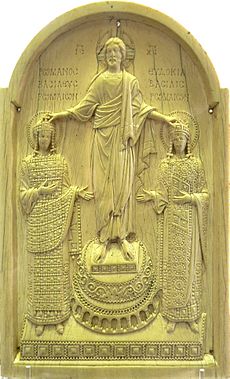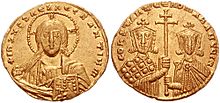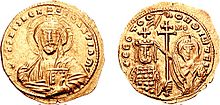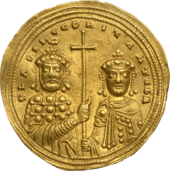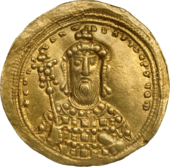Constantine VIII facts for kids
Quick facts for kids Constantine VIII |
|
|---|---|
| Emperor and Autocrat of the Romans | |
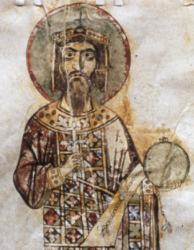
A picture of Constantine VIII from his time, found in a Bari Exultet roll
|
|
| Byzantine emperor | |
| Reign | 15 December 1025 – 11 November 1028 |
| Coronation | 30 March 962 |
| Predecessor | Basil II |
| Successor | Romanos III |
| Born | 960 |
| Died | 11/12 November 1028 (aged 67–68) |
| Spouse | Helena |
| Issue | |
| Dynasty | Macedonian dynasty |
| Father | Romanos II |
| Mother | Theophano |
Constantine VIII Porphyrogenitus (which means "born in the purple" or "born into royalty") was a Byzantine emperor from 962 until he died in 1028. He was the younger son of Emperor Romanos II and Empress Theophano.
Constantine was a co-emperor for most of his life, first with his father, then with his stepfathers Nikephoros II Phokas and John I Tzimiskes, and finally with his older brother Basil II. When Basil died in 1025, Constantine became the sole emperor. He had been a co-emperor for 63 years, making him one of the longest-reigning Roman emperors ever.
However, Constantine was not very interested in politics, government, or military matters. During his short time as the only emperor, the Byzantine Empire faced some challenges due to his lack of attention. He didn't have any sons, so his daughter Zoë's husband, Romanos III, became the next emperor.
Contents
Constantine's Family Life
Constantine's father, Romanos II, was the sixth emperor from the Macedonian dynasty. After his first wife died, Romanos II married Theophano, who was known for her beauty.
Theophano and Romanos had four children. Constantine was born in 960, and his older brother, Basil II, was born in 958. Their sister, Anna, was so important that Vladimir I of Kiev became a Christian just to marry her.
When he was eight years old, Constantine was supposed to marry a daughter of Emperor Boris II of Bulgaria. But in the end, he married a Byzantine noblewoman named Helena, daughter of Alypius. Constantine and Helena had three daughters:
- Eudokia, who became a nun.
- Zoë, who was empress for 22 years.
- Theodora, who ruled for 18 months and was the last ruler from the Macedonian family.
Constantine's Life Journey
His Childhood Years
Romanos II, Constantine's father, died suddenly in 963. Even though Constantine was only three years old, he had already been crowned co-emperor the year before, around March 30.
After Romanos died, his wife Theophano became the ruler for her young sons. She put her supporters in charge of the government. However, she faced a challenge from Joseph Bringas, an advisor to Romanos. Theophano then teamed up with Nikephoros Phokas, a famous general. Nikephoros promised to protect her children if she married him.
A few months later, Nikephoros's supporters removed Bringas from power. Nikephoros was crowned emperor, with Constantine and Basil still as co-emperors. A month later, he married their mother.
Six years later, Nikephoros was killed. John Tzimiskes, who was Theophano's lover, became the new emperor. Tzimiskes sent Theophano away, but Constantine and Basil remained in the capital as co-emperors.
His Adult Life
John Tzimiskes died in January 976. At this time, Constantine was sixteen years old. Basil and Constantine became the new leaders of the empire. They were supposed to be equal, but Basil took his duties very seriously and became the main emperor.
Constantine, however, was not interested in government work. He never really developed a passion for it. He did join one military campaign in 989, but there was no fighting. Instead, he spent his time on other hobbies.
When he was young, Constantine was tall, graceful, and good at sports. He had a great speaking voice and was good at talking. He enjoyed wrestling, which he helped make popular again, and he loved training and riding horses. He also really enjoyed food. This love for food later caused him to have a painful joint condition that made it hard for him to walk.
Constantine as Sole Emperor
Basil II had a very successful reign, making many government changes and winning several wars. He died without children on December 15, 1025. Constantine, who was 65 years old and a widower, then became the sole emperor as Constantine VIII.
During his many years as co-emperor, Constantine had enjoyed the benefits of being royalty without worrying about running the country. Becoming the only ruler did not change his desire to "enjoy extravagant pleasures."
Basil II had kept the Byzantine noble families under strict control. But the nobles saw Constantine as someone they could easily influence. They worked to get special favors from him. People who were not qualified received important government jobs. Also, Basil's laws about land were changed because of pressure from the nobles in Anatolia.
However, dealing with Constantine could be risky. If he felt challenged or suspected someone was plotting against him, he could react with sudden harshness.

Some historians believe that the decline of the Byzantine Empire began when Constantine became emperor. His reign has been described as a difficult time for the empire, causing problems for its military strength.
Constantine ruled for less than three years before he died on November 11 or 12, 1028. On his deathbed, and with no sons, Constantine first chose Constantine Dalessenos, a respected noble, to be his successor. The plan was for Dalessenos to marry the emperor's daughter Zoë to secure his position.
But before Dalessenos could arrive in Constantinople, the situation changed. The emperor's advisors preferred a different candidate, Romanos Argyros. They thought Romanos would be a weaker ruler whom they could control. Constantine agreed to this change. Romanos was named the new heir and was made to divorce his current wife and marry Zoë. The wedding happened on November 12, and Romanos was crowned emperor four days later.
See also
 In Spanish: Constantino VIII para niños
In Spanish: Constantino VIII para niños


